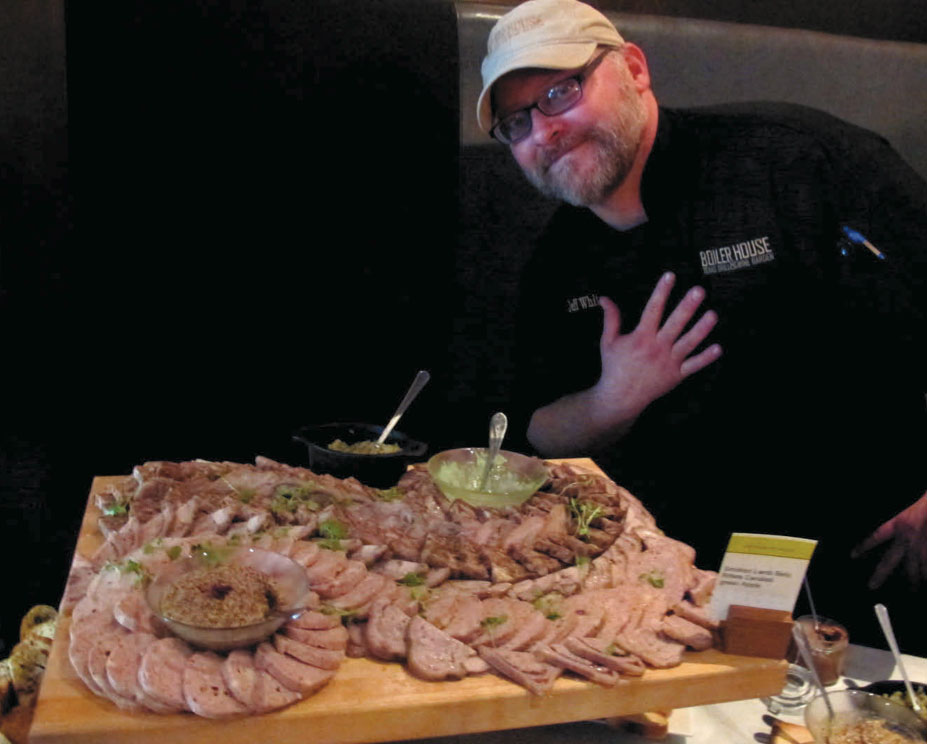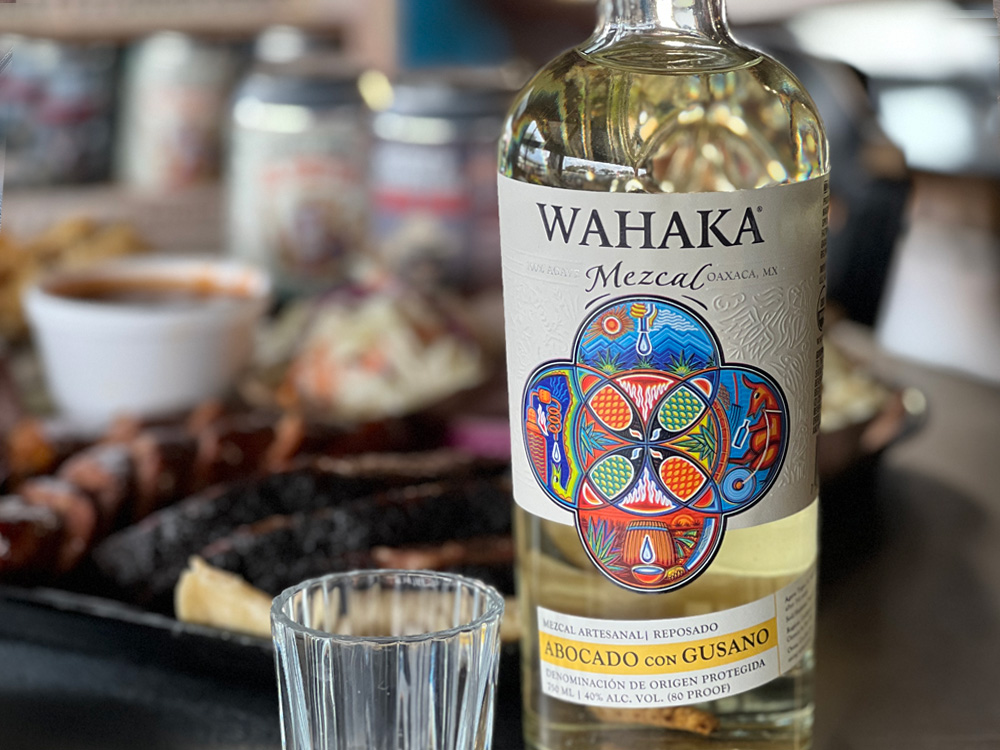
FROM OUR FIRST ISSUE, Edible celebrates the people who cook our food in our Meet the Chef series:
Step into the Boiler House these days and peek into the kitchen. Chances are you’ll see Executive Chef Jeff White working shoulder to shoulder with his staff. Easygoing and friendly, the 41-year-old chef said his pet peeve is a messy kitchen.
“Sloppy decks mean sloppy thinking. Everything just moves a lot more smoothly when everybody cleans up as they go along,” Chef White said. Making sure things move smoothly is a major consideration in a kitchen that turns out about 600 covers on a weekend night.
Chef White gravitated to the culinary arts as soon as he could start working “officially” at age 15. He began his career at Tom’s Ribs on Nacogdoches Road … washing pots. He worked his way through high school in that kitchen, cleaning dishes, bussing tables and chopping vegetables.
“All the cool guys there were cooking, so I really wanted to be on the line, too,” he said. He finally got the chance just shy of turning 18 — as a fry cook.
“I was the fry guy, making all the onion-ring loaves and the fried trout. I remember when things would slow down, we would take the trout heads and line them up on the dishwasher with cigarettes in their mouths,” he said. “We were just kids in the kitchen then.”
When he graduated from high school, managers at Tom’s ceremoniously offered him a job in the kitchen for $4.75 an hour.
“So I went to college,” he said.
Chef White did not study culinary arts, though. Instead, he delved into mechanical engineering at Texas State Technical College.
“I was married, with a baby, and I needed a real job. So I went to work at Palmer’s in San Marcos and landed a job as a line cook. Having a full-time job and being a full-time student was very tough with a young family,” he said.
Somehow, he managed. Even before graduating, the San Antonio native became executive chef at the upscale Hill Country restaurant and worked there three years.
“As a line cook, I got the chance to create a few specials and they named me exec chef, but I didn’t know a thing about running a kitchen and relied on accounting majors and lots of other people to show me how to do this and how to do that. They never really knew what I didn’t know, I don’t think,” he said.
“I just couldn’t pay attention — I was always thinking about food,” he adds.

After college, he took a job drafting for a construction company, but was always thinking up new dishes, creating joy in the kitchen.
Since then, working 10 to 17 hours a day is part of his routine. Chef White said he wouldn’t have it any other way, and his family life is interwoven with his vocation.
“Finding a balance between personal and work life is always tricky, but no matter how hard you work or how tired you are, you find a way to make time, even if they (relatives) have to come to the restaurant to celebrate a special occasion,” he said.
His daughter, Kaileigh, now 18, is at the Navy boot camp on the Great Lakes in Michigan. And this time he’ll be going to celebrate with her.
“I get to go see her graduate in Chicago next month,” he said.
But there was a point in his career when taking time off wasn’t in the game plan.
On his quest to become a great chef, he sought the best and most reputable masters to help hone his skills. He received a warm welcome into the kitchens of some of the area’s most acclaimed restaurants: from Louis 106 in Austin and L’Etoile in San Antonio to Chef Bruce Auden’s Biga on the Banks, the Westin Riverwalk, Restaurant Acenar and the Grey Moss Inn.
“I’d have to say I was most influenced by Chef Bruce Auden of Biga on the Banks. He allowed me to build my own style. Bruce really taught me how to run a kitchen and with his Chef de Cuisine Martin Stembera, I learned a lot about Asian techniques,” he said. “Almost everything I know about French techniques I learned from Thiery (Burkle of L’Etoile).”
The idea of buying fresh and local made the biggest impression.
“Bruce used lots of locally sourced ingredients and I learned how imperative it is to buy local and be connected to where your food comes from,” Chef White said.
By 2008, less than 10 years after officially switching careers, Chef White was appointed executive and corporate chef for the Columbia Culinary Team. An opportunity to work with Chef Johnny Hernandez at True Flavors Catering beckoned three years later and during 2012 he was invited to help open The Boiler House at the Pearl. Just a year later, he became executive chef.
He’s accumulated accolades and awards, including First Place in the San Antonio Herb Fair in 2003 and The People’s Choice Bronze Award for Taste of Elegance in 2005. Chef White was also an American Culinary Federation Guest Chef at the James Beard House in New York City.
In his relatively new role at The Boiler House, Chef White creates marvelous menus and fosters a collaborative atmosphere.
“I‘ve been in almost every role in many kitchens and I got to see and practice many management styles. Where I feel most comfortable is as a mentor — in my kitchen we all work together. I learned the best way to manage is by example. I wouldn’t ask anybody to do anything I wouldn’t do and I don’t like to see idle hands,” he said.
Chef White especially enjoys preparing charcuterie, the art of cooking, curing and preserving meats, pâtés, foie gras and confits.
“Making prosciutto from scratch, creating mortadella from sweetbread and lamb tongue or pastrami from duck breast takes time and plenty of labor, but the specialized techniques are wonderful. Learning to use the kidneys, the heart, the feet parts of the animal, parts of an animal that are all delicious and underutilized today, is essential in my book,” Chef White said.
Many of the chef’s techniques are rooted in centuries-old traditions and methods that use the whole animal.
“You’re not wasting any part of the animal that died — that shows respect for the farmer and the animal,” he said. “When creating a plate, we reach for a balance of flavors of textures. It’s easy to get lost in the technique and forget the goal — but the idea is to present the cured meats in their most natural state to preserve the flavor and quality — and it’s important to stick with the old-and-tested traditional methods to achieve the best results,” he added.
While the meat-centric Boiler House serves up charcuterie, mouth-watering steaks, grilled skewers and even game, the restaurant also offers plenty of salads and vegetables — almost all of it from local farms. And on the weekends, Chef White often walks around the Pearl Farmers Market just outside the restaurant’s door and buys fresh produce directly from the farmers.
“Working at Biga on the Banks opened my eyes to this concept. You can develop a personal relationship with the people you buy from – you know where your food comes from, how they grow it, sometimes you even get to see the places it comes from,” he said.
That’s a good thing, too, because by necessity, whatever they choose to cook at the restaurant has to be fresh.
“There’s no fryer at the Boiler House,” he said with a smile, “and there’s no freezer here, either. So everything we make is fresh.”
Chef White explained the thing he loves most about his work is the sense of community among the food professionals in San Antonio. He is a member of a new chefs group, the Chef Cooperatives, with a mission to support area farmers through special events and locally sourcing menus as much as possible.
“I love the chef community here — we support each other and each other’s restaurants; we promote each other. Our camaraderie allows us to experiment and elevate the food scene here for everyone in the city, and everyone contributes to make it happen,” Chef White said.
For more information, visit the THE BOILER HOUSE, 312 PEARL PARKWAY BUILDING, SAN ANTONIO, TX 78215 or call them at (210) 354-4644. (This article is updated from the original version printed in the magazine.)






